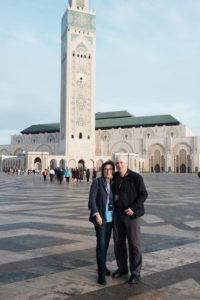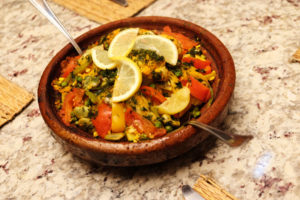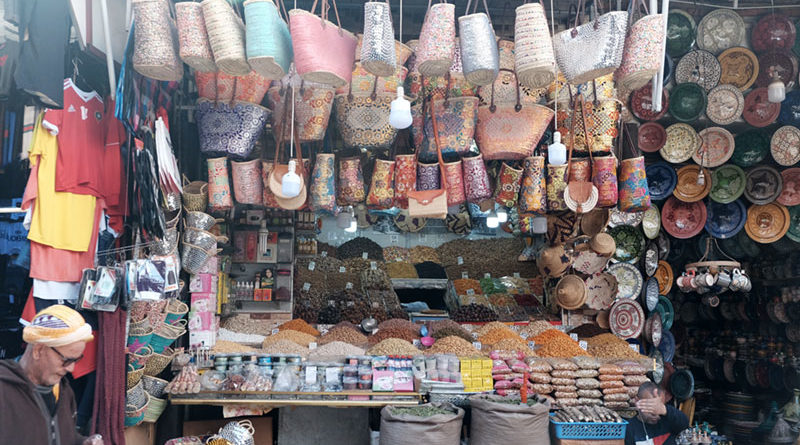Morocco for Visitors: Expect the Unexpected
By Carol Radin

Suddenly I was Ingrid Bergman! Descending the stairs of the plane in slow-motion, the wind whipping my hair around my face cinematically, then standing on the very tarmac — I was sure — where she once bade farewell to Humphrey Bogart. Ah, Casablanca!
In early March, my husband and I went on a one-week tour of Morocco with a group from Syracuse’s Temple Concord. Our plan was to explore the old world of Jewish communities that had once proliferated in Morocco, and to learn about Muslim religious sites and present-day culture. It was a marvelous opportunity to be in a place where two worlds had once converged and yet were different.
We visited four cities — Casablanca, the major port and financial capital; Fez, ancient and beautifully preserved; Rabat, the stately capital; and Marrakesh, with its trendy, resort flair. Our daily walking tours covered fascinating holy sites, museums, gardens, seaside vistas and even the breathtaking foothills of the Atlas Mountains. It would be hard to single out highlights, but I’ll try.
Holy Sites, Memorials, and Places of Learning
In Casablanca, we started with the majestic Hassan II Mosque, which dominates the city’s panorama with the tallest minaret in the world at 689 feet. The location itself is magnificent: a vast sand-colored plaza meets a backdrop of blue oceanfront in a dramatic blend of nature and construction. Inside the mosque itself, visitors are engulfed in a 200-foot-long prayer hall, which can accommodate 25,000 worshippers! Every inch of the soaring walls is embellished with intricate mosaic of blues, marble and granite accents, bordered by carved stonework arches. Non-Muslim visitors can enter only with a tour guide, and all must take off their shoes inside the doorway before walking on the gleaming glass floor. We learned that worshippers perform a ritual cleaning of their faces, hands and feet before praying, so the stone-floored bathrooms are long spaces with shallow washing troughs for at least 25 people. The beauty of this prayer hall and the breadth of its spiritual rituals make this Mosque a must-see.
Afterwards, we had a seafood lunch on a breezy restaurant deck overlooking the ocean and watched the many Moroccan families strolling at their leisure.
After a day and a half in Casablanca, it was on to Fez, where we plunged into the Medina, which means “town” or “city” in Arabic and now refers to the old part of the city. We spent five hours in the Medina, and it was admittedly jarring. Narrow, uneven cobblestone streets gave me a closed-in feeling. We dodged mopeds buzzing just inches past our elbows and toes, pack animals carrying wares and merchants pushing handcarts, sidestepped the occasional plop of dung and bird waste, and tried to ignore the skinny cats at every turn. The streets smelled of dust, dung, cigarette smoke, cooking stoves. The merchants shouted for us to make way for their handcarts or cried out from their shops to show us silver bracelets, pottery and purses. If I dared turn toward a shop, yet another moped would speed past and I’d have to jump! Although fascinated and amused, I was frankly ready to go home, like New York-suburb-home.
Back at the hotel that night, I gave myself a pep talk. I would have to go with the flow. After all, I had not come for Disney World. I had come to see how different Morocco could be. Once I acclimated to expecting the unexpected, the trip got better.
And to be fair, I saw many wonderful sites that day. Inside Fez’s Medina, the 14th century Madrasa Bou Inania, an institution of learning for Muslim scholars and one of their few religious places that non-Muslims can visit, was a beautiful study in Muslim architecture. It is the only Moroccan madrasa with a minaret, its tiled and carved motifs a fitting tower for its scholarly place in Moroccan history. Elbow to elbow with other tourists, we entered a sunny courtyard bordered by tiled columns and pointed arches, open areas of stucco walls with cedar wood accenting the windows, and small austere rooms for study and prayer. Another place of learning in the Medina is the University of Al-Karaounine, or Al-Qarawiyyin, a UNESCO site and one of the oldest operating degree-granting universities in the world. As non-Muslims, we were able only to peek into the serene stone courtyard, where students were removing their shoes and preparing for prayer.
In Fez’s Mellah (Jewish neighborhood), we toured two old synagogues, in particular the 17th-century El Fassiyine synagogue which the Foundation of Moroccan-Jewish Cultural Heritage had helped to restore to its former simple splendor in collaboration with the German Foreign Ministry. To our group, Morocco’s part in the restoration was affirmation for the country’s Jewish citizens — which now number under 3000, where once the Jewish population was around 250,000. El Fasssiyine, no bigger than the first floor of a modest Western house, had striking floor tiles of gray and white zigzag design, old metal ceiling lanterns, and archways and stucco walls of faint coral.
For grandeur and a glimpse into the 12th century, our next city, Rabat, was a treasure. During our visit, Morocco’s current King Mohammed VI was in residence in the Royal Palace, where palace guards stood sentry in crisp red coats. In Morocco’s constitutional monarchy, the king has extensive powers, and appoints the prime minister and members of Parliament.
Mohammed VI’s late father Hassan II and his grandfather Mohammed V are laid to rest in a magnificent mausoleum in Rabat. Amidst another dramatic ocean backdrop, visitors enter and view the gleaming onyx tombs from a wrap-around balcony above. The surrounding walls are inlaid with interlocking designs and geometric patterns in earth colors and deep blues, a grand design for an environment of reverence and reflection.
Not far from the mausoleum is the old walled city and Kasbah des Oudayas, a sedate area of narrow hilly streets and stone facades, where little has changed since the 12th century. We meandered through lush areas of orange trees hanging low with clusters of fruit and panoramic ocean overlooks viewed through dramatic archways or from small cafes with stone tables.
For our last stop on tour, Marrakesh was truly a grand finale. The Floridian-like pinks and corals of resort hotels and apartments, the stylish boutiques and cafes, and the exuberant open markets were captivating. A city of contrasts, Marrakesh also offers architectural sites of historical and religious significance. It was there we visited two synagogues, most notably the blue and white-tiled Slat Al Azama Synagogue, established in 1492 when Jews fled from persecution in Spain and Portugal. Turning once again to Muslim history, we saw the Saadian Tombs, commemorated to the 16th and 17th century Saadi Dynasty, with columns of fine stonework like lace, the mosaic tiles typical of Moroccan architecture, and a solemn garden cemetery. The Bahia Palace was another highlight, a grand complex from the 19th century named after the favorite wife of the owner, the grand vizier of the Sultan. “Bahia” means “brilliance,” and the tiled courtyard surrounded by gleaming colonnades of yellow, green and blue bear out the name. The grand vizier had more than simply a favorite wife. Many of the rooms off the courtyard garden were quarters for his harem of 24 concubines!
The Street Markets
Travelers to Morocco must shop in the street markets — those endlessly entertaining high-decibel warrens of stone-cobbled streets that defy street maps. In Marrakesh, a visitor’s initiation to the “souk” begins in Jemaa el-Fna Square, a crazy canvas come alive. Men with live snakes thick as boas wrapped around their necks, monkeys on leashes, hand-and-toe jugglers, snake charmers with sleepy snakes, camel rides, bracelet peddlers — and those mopeds! Where to go first? Here in the U.S., I would never browse through four consecutive shops of paisley harem pants. In Marrakesh, it just made sense. We could have all the pants, gauzy skirts, djellabas, tagine pots, wood carvings, stringed folk instruments, key chains and bargain store socks we wanted. Or how about a whirlpool washing machine? Before we disbursed for the markets, our guide had cheerfully advised, “Do not show the slightest interest or touch ANYTHING unless you’re ready to buy it.” He was right. The merchants are good at putting closure on a sale. If I engaged in a conversation with them at all, they would have me convinced in two minutes that I couldn’t not buy something, since I myself had just admitted that, yes, the blouse was pretty and therefore worth the price.
Morocco is known for its tanneries, Berber carpets, and argan oil, a rich moisturizer with anti-oxidant properties for skin and hair. We visited high-end shops for each of these products. The tannery in particular, where we toured the processing facility, was like a place out of time. We climbed to the fourth floor where we got an overview of the courtyard below, an expanse the size of a sports field with a honeycomb of giant barrels of dye, in purple, sapphire blue, brick red, ruby red, tan, gold; shapeless white skins drying on clotheslines; and busy workers balancing on the barrel rims. The finished products were jammed in showroom after showroom: racks of every crayon color of jacket and trench coat imaginable.
Likewise the Berber carpet shop, where roll after roll of 8 by 10’s and 9 by 12’s were lowered at our request and whipped open on the floor, so striking in their contrasting patterns that they seemed to glow. This was the place to purchase a carpet, and several in the group did so. As the shop’s owner promised, the carpets, even the larger ones, were delivered to the buyers’ doors in the States within days of the end of the trip.
The Food, the Food, the Food

No trip to Morocco would be complete without trying all the food — the tagines with their stacks of squashes, onions and couscous; the oily lamb shanks; the seafood fresh from the ocean and batter-fried; and the crispy pastille — Morocco’s version of the meat turnover. Day after day at lunch and dinner, we never tired of the heavy tagine pot being lowered onto our table and its funnel-shaped lid lifted to reveal the steaming chunks of red, green and yellow vegetables beneath. The lamb and brisket, also amazing. A few of us had our most memorable meal in the Marrakesh souk, in a simple open-air dining room with formica tables where mostly Moroccan men sat eating. There was one entrée: a cafeteria tray spread with parchment paper and stacked with a cut-up side of lamb, tender and oiled with preserved lemons, which we ate mostly with our hands. Morocco’s French influence shows up, too. Who could resist those glass bakery cases of brioche, chocolate croissants, and Madeleine cookies? And of course—espresso! Then there is the Moroccan mint tea, which spoiled me for mint tea forever. It is served steaming in clear glass cups, so the diner can see the lush green mint leaves curled inside, fragranced with honey.
What Not to Take For Granted
Although Morocco makes for a fascinating trip, U.S. visitors will encounter inconveniences. One in particular is the plumbing and bathrooms. While our hotels were part of well-rated chains with comfortable facilities, that is not always the case when venturing out to the venerated cultural sites and markets, where the facilities often have old bathroom fixtures and scant soap and toilet paper! Tissues and hand sanitizer are a must. So is bottled water; the tap water is not for drinking. I also observed that there are few accommodations for wheelchairs and people with walkers. The many staircases are often stone and often steep. It was not at all unusual to enter restaurants and shops that went up and up and up, four levels. If someone needs alternate access to buildings and more frequent restroom stops, it is advisable to check for elevators before visiting particular sites.
All in all, though, so much of what was wonderful still resonates with me: the sunny shirtsleeve weather, the Muslim call to prayer that sounds daily across the city spaces, the sand color of streets and stone facades, the remarkable architecture and veneration for religion and history, all bumped up against the noisy marketplaces and steaming street food. I’m so glad now that I didn’t yearn for my New York-suburban home the entire time I was there!
Photo: So much merchandise at the markets! I should have bargained for two-for-one!

